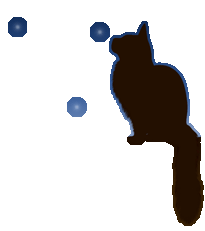![]() here are many aspects to a proper Somali, including the general "type" of the breed and the individual colour combinations. On this page you can read the General Type Standard.
here are many aspects to a proper Somali, including the general "type" of the breed and the individual colour combinations. On this page you can read the General Type Standard.
Jump to Breed Standards per Colour.
General Type Standard
The General Council of the Cat Fancy (GCCF) lists the general type standard for Somali cats as follows:
The Somali should be a beautifully balanced, semi-longhaired cat of medium build and foreign type. The head to be broad and curving to a firm wedge set on an elegant neck. The body to be firm, lithe and muscular of medium length, tail fairly long and tapering. The head, body, legs, feet and tail should be in in proportion, giving a well-balanced appearance. The expression should be alert and smiling. The cat should be in excellent physical condition with good weight for size.
Head - A moderate wedge with brow, cheek and profile lines should gentle contours. There should be a slight rise from the bridge of the nose to the forehead which should be high with good width between the ears. From the front, a shallow indentation should form the muzzle. In profile, a slight nose break is essential, a firm chin and an elegant neck.
Ears - Set wide apart but not low, broad at the base, proportionately large, pricked, well-cupped and tufted. Inner edge well furnished with long hair.
Eyes - Large, almond-shaped, set obliquely and well apart, expressive and bright. Accentuated by a dark surround encircled by lighter coloured, "spectacles". Short dark "pencil" lines at either edge of the eye, the inner one vertical, the outer one pointing towards the ear. Colour: amber, hazel or green: the richer the better.
Body - Firm, lithe and muscular of medium size, foreign type with a level back.
Legs and Feet - Long legs. Feet oval with tufts between the toes.
Tail - Long, well furnished, broad at the base and tapering slightly with a full brush. Length to balance with the body.
Coat - Soft and fine, dense but lying flat along the spine. Medium long except over the shoulders where a shorter length is permitted. All other points being equal, preference should be given to the cat with a ruff and full breeches. Ruff and breeches may not be apparent in kittens.
Colour and Pattern - Ticking is the essence of the Somali coat. There should be at least three bands on every hair, ie six contrasting colour sections from base hair to tip. Ticking is slow to develop, but should be apparent at least on the shoulders of all kittens.
Ear tips and tufts, facial markings, top and tip of tail, toe tufts and heels are the same colour as the ticking. Darker shading along the spine and top of tail is desirable.
Chest, belly, under tail, inside of legs and breeches are the same colour of the unmarked base hair.
Depth of colour in sex-linked colours may not be achieved in kittens or young cats, as this develops with maturity.
Withhold all awards for:
1. White locket or white patches anywhere except around the chin, lips and nostrils. (This does not apply to silvers).
2. Absence of ticking in adults.
3. Unbroken necklace.
Withhold Certificates or First Prizes in Kitten Open Classes for (in addition to General Type Standard):
1. Cobby or oriental type.
2. Pinched muzzle.
3. Straight profile or stop.
4. Absence of facial markings.
5. Incorrectly coloured heels (Heel colour in silvers may not extend to the hock).
6. Severe barring on legs, body or tail.
7. Any veterinary defect as listed.
Scale of Points
| Head |
15
|
| Ears |
10
|
| Eyes |
10
|
| Body |
10
|
| Legs & Feet |
5
|
| Tail |
5
|
| Coat | |
| Colour |
15
|
| Ticking |
15
|
| Texture |
5
|
| Length & Condition |
10
|
|
Total:
|
100
|


